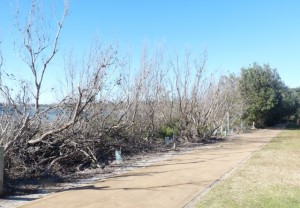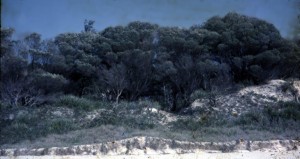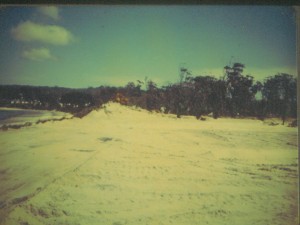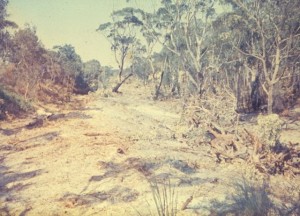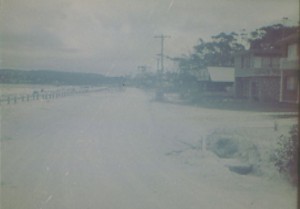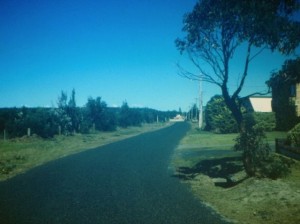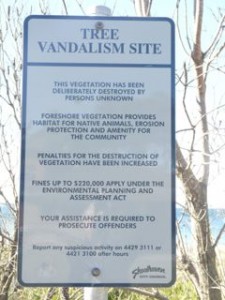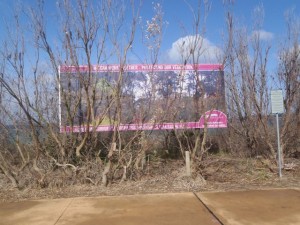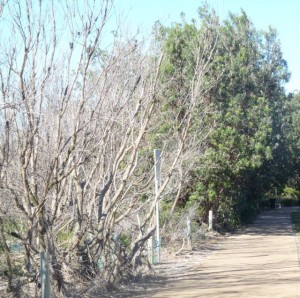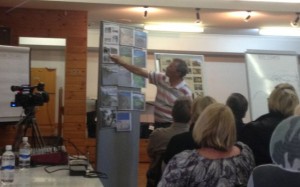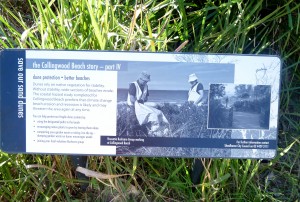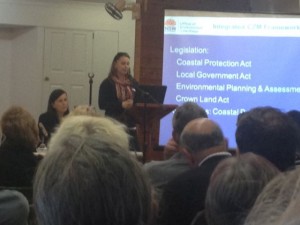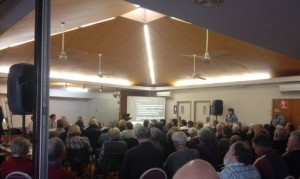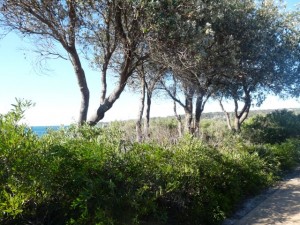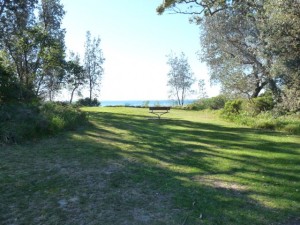I think that I shall never see
A poem lovely as a tree
(PART ONE – first published July 22, 2014)
Up and down the coast and along our waterways there is a clash between public land management and the private desire for a water view. The private desire, which some foreshore property owners see as a right, sometimes leads to destruction of vegetation on public land.
This is illegal and penalties can be severe – with fines of up to $220,000 – but prosecution is difficult without evidence. Someone has to be caught in the act. The position of a house adjacent to damaged vegetation is not, in itself, evidence.
While far from the worst in New South Wales, Shoalhaven Council on the south coast has its fair share of this problem. Within Shoalhaven, Collingwood Beach at Vincentia captures the heart of the conflict. And it is a many-layered conflict.
This essay starts by presenting some facts, of science and law, before looking at the history of Collingwood Beach, from the late 1960s to mid 2013, and then more recently. Along the way I provide observations and perspectives. This is part one of the story of Collingwood Beach. Lessons to be learnt from this story may have application far beyond.
I start with an acknowledgement of my interest in this matter:
- I use the pathway behind Collingwood Beach regularly
- I am a member of, and an unreliable contributor to, a local Bushcare group
- For six years a business of which I was a director was contracted to Shoalhaven City Council to provide support to Bushcare groups
Fact #1 – the science
Coastal dunes limit the landward intrusion of water, wind and salt spray; act as a barrier to oceanic inundation and provide a transition from the marine/ aquatic to the terrestrial environment.
Coastal dunes are dynamic systems, constantly changing, with sand erosion and accretion (build up) being natural processes. During storms the front of a dune is eaten away and sand taken out to sea, forming a sandbar. Following this, sand is returned to the front of the dune.
Dune vegetation has three distinctive zones: primary, secondary and tertiary. The primary zone of grasses and creepers occupies the lower parts of the beach and provides a foundation. The secondary zone is mainly shrubs and provides wind deflection. Taller shrubs and trees make up the tertiary zone, further elevating the wind and providing increased shelter inland.
Dune stability relies on this gradation of vegetation.
A state government Coastal Dune Management Manual provides more detail.
Fact #2 – the law
In New South Wales foreshore reserves are under public ownership and managed by various levels of government.
Shoalhaven City Council’s Foreshore Reserves Policy outlines foreshore reserves as either Council Land (Community Land) or Crown Land (with Council as Trust Manager). State government legislation sets out how these reserves are to be managed. Under different legislation environmental protection is paramount for both classes of land.
The Local Government Act 1993 core objectives for management of Community Land categorised as foreshore are: to maintain and protect as a transition between the aquatic and terrestrial environment; and, to facilitate ecologically sustainable use, mitigating impacts by community use.
The Crown Lands Act 1989 requires Council to: observe environmental protection principles; conserve natural resources where possible; and, encourage appropriate multiple use of Crown Land. Management should be in the best interests of the people of NSW.
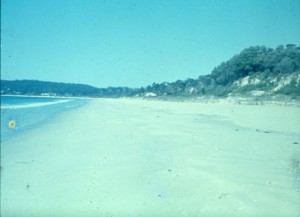
Collingwood Beach, circa 1965. The extent of the dune system is apparent. The gradation of vegetation from grasses on the seaward side, through to low and small shrubs, with large shrubs and trees at the back of the dune is also clear. Photos courtesy Noel Kesby
Collingwood Beach, from the late 1960s
In the late 1960s the frontal dune was levelled for residential development with sand pushed inland to fill an existing wetland. This frontal dune extended to somewhere between the middle of Ilfracombe Road and the building line of the houses. A development like this would not be allowed now under current planning laws.
Levelling of the frontal dune: late 1960s. Photo courtesy Noel Kesby
Major storms caused severe damage in May and June 1974. A storm of lesser intensity in July 1975 added to the damage. The foreshore reserve was reduced in width from about 30 metres to an average of about 17 metres, and as narrow as 7 metres near Berry Street.
By late 1977 sand drifting inland cased major problems. Ilfracombe Street and household gardens were covered with sand, which blasted paint from houses and, in some cases, billowed in under eaves causing ceiling collapse. Real-estate values fell accordingly.
The Collingwood Beach Progress Association sought help from Shoalhaven Council and the NSW Soil Conservation Service. In January 1978 an on-site meeting agreed on the development of a beach management plan. This covered an area of about 1.5 kilometres between Moona Creek and Susan Street. Council adopted the plan in May 1978.
Restoration work was carried out between May and September 1978. This included reshaping the frontal dune using a bulldozer and the planting of marram grass and sand spinifex. This work also addressed road drainage and beach access.
In September 1978 a sub-committee of the progress association assumed responsibility for ongoing maintenance, including the planting of 1,500 shrubs and small trees. These were coastal species of: a low growing wattle, often prostrate but generally no more than two to three metres; a teatree, that can reach up to five metres in height with a similar spread; and a banksia, a small to medium tree, often no more than five metres but up to 15 metres on favourable sites.
Collingwood Beach: Showing area of initial dune restoration – 1978 (from Susan Street in the south to the (Moona) Creek north of Collingwood Beach
In January 1982 the NSW Soil Conservation Service reported on the restoration work which had “achieved a favourable result with the limited amount of sand available, at a reasonable cost and within a relatively short time.” This was the first Dune Care project in NSW and it was noted that: “Local community interest and involvement in this project has been outstanding.”
Further serious storms in 1986 caused some damage to the dune with sand drift inland, but the re-established dune vegetation limited this. The dune was able to recover naturally.
By the late 1980s however, the private desire for a view had resurfaced with instances of vandalism noted. After some large Banksia’s were cut down at the southern end of Collingwood Beach in 1990 a public meeting was held. Passionately held views were expressed from both sides before consensus was reached that action needed to be taken. A community planting, of low growing species, was held and a Dunecare group formed.
Three views of Ilfracombe Street (looking south)
Under construction, late 1960’s
With effects of sand drift, 1977
After dune restoration, 1983-4 Photos courtesy Noel Kesby
In the 24 years since, regular destruction of vegetation has continued – alongside the restoration efforts of the Dunecare group, which later became a Bushcare group.
It’s worth remembering the Collingwood Beach dune restoration project was widely seen as a model of community and government agency cooperation, working in the public interest. So it isn’t difficult to imagine the frustration that has arisen within the local community. Overseen by Shoalhaven City Council.
In matters of local government it is always important to distinguish between the decision making and actions of staff, and of elected Councillors. At the elected Councillor level, Shoalhaven Council’s longstanding approach to tree vandalism could be described as indifference at best, negligence at worst.
Other Councils faced with tree vandalism have displayed determination and consistency in their response. This has included installing large signs, shade cloth, hazard tape and even shipping containers as a deterrent. The Hunter region group of Councils, for example, has a protocol for investigation and response to tree vandalism. This provides a consistent response based on severity and frequency of vandalism.
Shoalhaven Council’s response has been to provide community education – signs, leaflets – and on occasion writing to residents in the immediate area around a vandalism site.
While it’s impossible to gauge the magnitude of something that hasn’t happened, in this case trees that haven’t been vandalised, it’s obvious that it continues with some level of impunity. No-one has been prosecuted, which may be the ultimate deterrent.
Occasional bursts of outrage come from concerned residents or the local Bushcare group. Council staff or some elected Councillors occasionally join the outrage.
It should also be noted that some elected Councillors have taken the stance that residents are entitled to a view, proposing only low growing plants on the dune. Serious criticism of Bushcare groups has come from some Councillors.
In accordance with its Foreshore Reserves Policy, Council has regularly erected small “Tree Vandalism Site” signs. Along the Collingwood Beach pathway there are at least 20 of these signs. In one section of about 100 metres there are six signs.
Some people, particularly nearby residents or homeowners, want these signs removed. Along with all dead trees. And all vegetation to be kept to a maximum height of 1.5 metres.
Recent history, from mid 2013
The long standing approach to tree vandalism at Collingwood Beach changed in May 2013 when a Council report included a recommendation to ‘trial a new approach to deter offenders.’ This was for the design and installation of a large banner at a recently vandalised site:
‘Instead of the negative language currently used on the signs, the banner should be designed to not become an eyesore but rather be sympathetic to the surrounding landscape … replicate the landscape that was vandalised and … convey “ value” statements …’
Quite creatively, the recommendation also proposed to nominate Collingwood Beach as a National Tree Day site. This new approach has potential application at other sites of foreshore vegetation vandalism in Shoalhaven, and possibly beyond.
Council resolved to install the banner for a trial period of three months. Council also decided to survey affected residents before and after the trial to determine their views. This had the support of the Vincentia Residents and Ratepayers Association and the local Bushcare group.
In August 2013 the results of the survey were presented to a Council meeting. This showed awareness of vandalism is high, vegetation on the dunes is seen to be extremely important and there is a very high level of support for Council to address the issue of vegetation vandalism. There was lesser support for the installation of the banner and a moderately low belief that the banner would be an effective deterrent.
People who responded to the survey were categorised as having been: in a house with a view; in a house without a view; or on the public pathway. Close reading of the survey results show those with a view placed a lower value on vegetation and were more negative towards the banner or any form of Council action.
Council decided at this August meeting to continue with the banner installation.
Announcing the installation of the banner in a Council media release of 25 October Mayor Joanna Gash said:
“Some residents are under the false impression that because they pay higher rates they are entitled to a view. There is no legal entitlement to a view and it is illegal to kill vegetation on public land.”
The banner was installed on 29 October 2013.
At least one local resident was unhappy and reportedly lobbied Council for the removal of the banner, threatening legal action against Council and against Councillor Amanda Findley who had commented on the matter on her blog. In a letter to the Council the resident said:
“What Council has forgotten is that the foreshore residents have higher land values hence higher council rates and Land Tax to pay. The high cost do not reflect the ability of the residents and holiday makers to enjoy and admire the views of one the best assets in the world, Jervis Bay. At the end of the day the local residents and holiday makers only get the opportunity to look at trees instead of the bay’s magnificent vistas.
The walkers and cyclists that use the pathways only have views into our rear back yards because they cannot see the Jervis Bay at all. This results in the residents’ loss of privacy. If the residents wanted to look at bushland vistas they would have purchased land in the bush and not on the foreshore.”
At a Council meeting on 10 December Councillor Andrew Guile successfully moved a motion to have the banner taken down. Guile said his initial support for the three month trial had been based “on support of local residents and I don’t think that ever happened.” This seems quite contradictory to the results of the survey.
Council also resolved to contact neighbours and express regret for reputational damage.
On 20 December the banner was taken down, a little short of two months into the three month trial period.
Some feel this was a weak, knee-jerk response to criticism and that Council should have stood by its initial decision.
The Vincentia Residents and Ratepayers Association expressed disappointment the banner was coming down before the trial was complete. Having lobbied Council for many years to take action the VRRA felt this was sending a message that vegetation vandalism would be tolerated and allowed to continue.
Members of the local Bushcare group believe there has been an increase in vegetation vandalism since the banner was removed, including the blanket poisoning of low shrubs.
In researching this story I asked Mayor Gash (on 10 July) if she still held to the view she expressed last October:
“Some residents are under the false impression that because they pay higher rates they are entitled to a view. There is no legal entitlement to a view and it is illegal to kill vegetation on public land.”
Her response:
“I don’t recall saying that. What I do say is if people purchase land on the seaside with a view they are entitled to that view. I don’t believe they are entitled to kill vegetation unless Council has given permission. And I’m very concerned about the type of vegetation planted on the foreshore.”
Because these comments seemed to be at odds to earlier comments I double checked. She saw no difference.
Gash added that she had been in favour of putting up the banner but there had been many complaints and she supported taking it down. “This was very close to the end of the three month trial,” she added. That statement is incorrect.
All Shoalhaven Bushcare groups have action plans, approved by Council. Approval was formerly given by staff but some years ago elected Councillors took on this responsibility. This says something about the level of controversy, and the level of political influence, that has attached itself to Bushcare in Shoalhaven.
In a concession to those with strong views about vegetation and views the Bushcare action plan for Collingwood Beach states that where teatrees are planted to replace dead banksias they can be pruned to a height of no less than 1.5 metres. The plan acknowledges the need to “build meaningful relationships with local residents.” While relationship building is a two way exercise this has clearly not been a great success.
Some local residents/ house owners believe the Bushcare group has been responsible for poisoning of some vegetation – either accidentally or through negligence. Or non-native species, which would probably not be accidental. “It’s only bad to kill a tree if you’re a property owner,” was one view expressed to me in research for this essay. “Any dead tree that doesn’t have a [Tree Vandalism Site] sign by it was killed by Bushcare.”
Recognising that some residents have strong feelings and believe they have a right to views from their land Council has sought legal advice, which:
“… leads Council to the opinion that residents cannot assert a proprietary [ownership] right over their views … Council recommends that members of the community obtain their own independent legal advice if they require clarification with respect to their rights.”
An April VRRA meeting decided to call for a meeting with Council. This was held in May and led to a decision to hold a public forum on Saturday 26 July. Here, an expert panel will deliver short presentations and answer questions. Council will also seek expressions of interest to become part of a reference group which will:
“… assist in providing recommendations for the future restoration and management of the dune vegetation. The group will also address and balance the values, opinions and ideas expressed throughout the forum as well as Council’s legal responsibility to protect and maintain the dune system.”
The results of the second part of the survey – which gauged public responses after the (shortened) trial period of the banner – will also be presented at the forum.
Most people go to public meetings/ forums with fixed positions. Some people see some of the well vegetated areas of the dune as a ‘green wall.’ Others see areas of extensive tree vandalism as a ‘wall of shame.’ Being open to new information or ideas that challenges fixed and often long-held positions is a challenge.
Understandably there is concern – from both ‘sides’ – about the forum and the representativeness of the reference group. Clarification of the role and responsibility of this group is important.
Underlying any conflict is a failure of clear and open two-way communication. And there is clear conflict here, between and among the various interest groups: the residents/ property owners, the Vincentia Residents and Ratepayers Association, the Bushcare group and the Council.
This has been evident in the local media and at meetings of VRRA where those with strong feelings about views and vegetation have recently taken to attending the association’s meetings. Rather than focusing on the issue at hand people sometimes find it easier to target individuals. Basic civility slips and there is an increased potential for conflict to become entrenched and even more personalised. Things can get out of hand.
On an issue causing significant public anxiety Shoalhaven Council has paid scant attention to its charter of exercising community leadership. The public forum of 26 July provides an opportunity.
Part two of this essay will report on that.
I think that I shall never see
A poem lovely as a tree
(PART TWO – published August 28, 2014)
It says something about the level of interest in an issue when a large crowd turns up to a public forum on a fine and sunny Saturday afternoon. Such was the case when Shoalhaven Mayor Joanna Gash welcomed 130 people to the “Collingwood Beach Dune Management Public Forum” on 26 July.
The group were not there, in Mayor Gash’s words ‘to debate or resolve anything.’ Rather the forum would hear from an expert panel and then, ‘most of all … listen to and document opinions and ideas about vegetation management at Collingwood Beach.’ The forum would also be a starting point for forming a reference group to work with Council on future management.
Some see stretches of dead trees as a ‘wall of shame’. Others see the densely vegetated areas as a ‘green wall’
Given the levels of conflict within the community on this issue Council could be forgiven for preparing for the worst, while hoping for something better. Indeed I imagine this was foremost in their forum planning. Generally well facilitated and managed, the facilitator asked for acceptance of ground-rules for participation: that people be allowed to speak without interruption; focus on the matter; stick to timeframes and be constructive. Facilitation 101 really, but you don’t always see it.
Minimal opportunity was available for the expression of outrage or the clash of conflicting views. This was no mean feat, but there may be a future price to pay for keeping a lid on that, for not allowing debate or clarification. More on this later.
The large group listened attentitively to the introductions and three expert speakers for the first 90 minutes, before an hour of question and answer.
Shoalhaven resident Garry Druett has worked in soil conservation and natural resource management for 40 years. This includes the Collingwood Beach restoration work in 1976, which gave immediate credibility. Having at least one member of the audience who had worked with him way back then added to his acceptability. It would have helped greatly though, if someone from Council’s organising group had helped organise his presentation to a large group. Even just a bigger white board would have helped.
Sediment compartments, recession, accretion and coastal retreat, along with incipient dunes, berms and sand sources were some of the terms introduced by the University of Wollongong’s Professor Colin Woodroffe. A coastal geomorphologist (geomorphology is the study of landforms and the processes that shape them) with an easy manner, Woodroffe was able to get across the message that ‘beaches ain’t beaches’. While they have some physical processes in common there’s a great deal of variability. And while Jervis Bay’s beaches are largely sheltered they are, like all beaches, dynamic.
Legislation relating to the coastal zone was the remit of Gabrielle Pietrini from the NSW Office of Environment and Heritage. The 1979 Coastal Protection Act is the main legislative device. ‘Protection of the coastal environment of the state for the benefit of present and future generations’ is the first objective. The take away message for most people would be that the legislation is complex.
A one hour YouTube video of the Mayor’s welcome, facilitator’s outline of the forum and the panel presentations is at: https://www.youtube.com/watch?v=vLiOe-HTixQ
The question and answer session is not included.
Key points made by the expert panel
Sensibly, a couple of questions were taken after each individual presentation, rather than asking people to hold questions until the end.
The first question was about dune vegetation zones (see part 1 page 2 for details), and particularly the minimum height of the tertiary vegetation zone. This is at the hind dune, closest to development, and the zone most likely to interfere with views and therefore most at risk of vandalism. The answer: ‘You could get away with 2.5 to 3 metres but the ideal height would be 4 to 5 metres.’
Other key points:
- Native plants are essential in dune vegetation and each part of the vegetation is inter-related
- Engineering solutions are generally not acceptable – being expensive and unsustainable
- The storms of the 1970s will recur, and eventually be even larger
- Infrastructure and development will be at risk
- Sea level rise will heighten the risk
- Dune vegetation is one under-estimated strategy in adapting to sea-level rise
- The Collingwood Beach dune system is ‘a stable system, accumulating sand where it should be, but could be strengthened’
Reference group
Nominations were sought with a closing date of August 8. People were asked to provide details of their technical expertise and experience working in multidisciplinary teams; analysing complex data; and responding to opposing positions. A daunting set of skills for many it would seem.
The group would have a limited number of minuted meetings within a limited timeframe.
The Terms of Reference and Application for the reference group is available here:
Survey
In her opening remarks Mayor Gash advised that the results of the banner survey would not be presented as this was seen to be ‘not consistent with the main purpose of the forum.’ It’s unclear why this is so, but a brief summary would be presented later in the meeting.
When the time came the extraordinarily brief summary was as follows:
- Pre banner: the majority were at least somewhat supportive of Council implementing the banner to deter vegetation vandalism
- Post banner: Just over 50% felt the banner would be likely to deter future acts of vegetation
It’s often said there are lies, damned lies and statistics. And so it may be here. For those interested in fine detail close reading of the survey is recommended. It’s here:
While related, questions about support for Council implementing the banner and about belief in its effectiveness are different questions (Q5 and Q6 in the survey). There was a school of thought that says: ‘Something has to be done, they [Council] have to try something. May as well give the banner a go.’
Response to these questions show:
- The level of support fell from 74% pre banner to 62% post banner
- Belief in the effectiveness of the banner fell from 61% pre banner to 47% post banner
One could wonder how these responses may have been different had Council held to its initial resolution and completed the three month trial, rather than giving in to pressure and removing the banner less than two months into the trial.
A survey question asked about the best options for reducing vegetation vandalism, with cameras and rewards receiving the most support. A lesser, but still significant 20% of respondents believed that keeping vegetation low was the best option. This group presumably includes (but is not limited to) those who have taken action to enhance views, and their supporters.
Selection of key issues
Generally when people are asked to nominate key issues in a public forum some attention is given to ranking. Here though, all issues were listed without any ranking, so it’s not possible to know whether a key issue was a widely recognised key issue, or a key issue for a very small number of people.
When people are given the opportunity to nominate their key issues it’s also commonplace for their preferred positions or desired outcomes to be expressed as an issue. A form of masquerade.
Key issues are summarised below, with some observations:
Examples of two preferred positions or desired outcomes masquerading as issues
- Limit the impact on foreshore residents through use of shrubs and view corridors
- Learn to see trees as part of the view
This is the heart of the conflict – the height of the dune vegetation – despite the advice from the expert panel member: ‘You could get away with 2.5 to 3 metres but the ideal height would be 4 to 5 metres.’
As I previously noted in part one of this essay: “In a concession to those with strong views about vegetation and views the adopted Bushcare action plan states that where teatrees are planted to replace dead banksias they can be pruned to a height of no less than 1.5 metres.”
As well as presenting an incentive to wish ill of a banksia, this appears quite incompatible with the expert advice.
Plant species selection and maintenance
- Careful selection of plant species for specific areas, eg. trees people can see through (rather than Banksias) and management of large trees
- Empowerment of foreshore residents to be involved in/ have responsibility for maintenance
Endorsing micro-management, such as careful and selective pruning is a can of worms. This is likely to be highly resource intensive for Council, and more importantly require cooperation, commitment and consensus from those with polarised views.
It is also likely to lead to expectations in many other areas of Shoalhaven where the conflict between vegetation and views arises. Which will be an added demand on Council resources.
Communication
- Needs improvement – particularly between the Bushcare group and residents – to bring the community together
- Signs – some take offence at use of the word ‘vandalism’ in signage and suggest there is a need for positive messages
High levels of tension exist. The ability to listen, understand the alternative position and compromise will be needed along with leadership from those in the reference group and Council.
In particular there will be a need to explain the decisions of the reference group and ensure transparency in their working. The public availability of meeting minutes may help.
Use of the word ‘vandalism’ in signs is widespread by local government and other authorities managing public land. The banner installed by Council combined “Council and the community condemn tree vandalism – It is an illegal act” with the more positive message of “We can work together – protecting our vegetation.”
Reference group
- Concern over how council will ensure its representativeness
- Communication with, and input to, the reference group
The parameters within which the reference group work will need to be widely understood beyond the reference group. Some issues will be negotiable and some not-negotiable. Among other things this should clarify what respect is to be accorded to the principles of foreshore management and what regard will be held for the law.It may have been far better for this to have been clearly stated at the forum, rather than kept for the exclusive consideration of the reference group.
Council’s terms of reference note a one-way flow of information from reference group members back to groups they represent, whereas opportunities for a two-way flow of information may lead to greater trust and ultimate acceptance.
In public foreshores consideration also needs to be given to the distinction between view corridors (such as at public access points and lookouts) and private views (where Council’s legal advice is that there is no legal right to a view.)
To come – the hard but admirable work of the reference group
There is a valid view that after many years of indifference or neglect Shoalhaven’s elected Councillors have now ducked their responsibilities. Instead of simply supporting the enforcement of the legislation and adherence to principals of foreshore management the easy approach has been taken of fobbing it off to a community reference group.
There is an equally valid view that this problem – which is not limited to Collingwood Beach – is so entrenched and views are so polarised that Council could not solve it on its own. It’s a community problem and the community need to be involved with Council in finding a resolution that people can accept and live with, even if it’s not their preference.
Conflict over environmental matters has the capacity to escalate and this is not limited to rural areas. Conflict exists between path users and adjacent residents. Many people from each ‘side’ believe the other ‘side’ will not accept compromise. During the forum it was apparent some weren’t open to new information, focusing instead on reinforcement of their existing position. “That’s their theory of foreshore management” was a comment heard during a break.
The continuing conflict was evident at a recent meeting of the Vincentia Residents and Ratepayers Association. A motion to consider electing a VRRA member to the reference group ‘and to establish guidelines for that representative’s representation of the Vincentia community’s views to the Reference Group’ was discussed.
Some believed that VRRA would have a member on the reference group, and/ or that the VRRA committee had made nominations. Two members of the VRRA executive had, as individuals, nominated as anyone was able to do. However the issue slips from focus and civility lapses when individuals become the target. After it was clarified that VRRA had neither made nominations nor supported any individuals, and as the closing date was well past, the motion was withdrawn.
For the recommendations of the reference group to have any chance of wide acceptance clear and open two-way communication between it and the broader community will be vital.
The reference group will need to work with known negotiable and non-negotiable parameters. These parameters need to be widely understood and accepted. Achieving acceptance will require uncommon levels of leadership and good will from all involved. Otherwise, nothing’s likely to change among those who believe they are entitled to a view. And the conflict within the community will become more entrenched.
